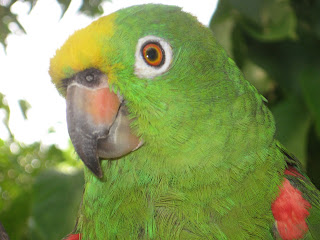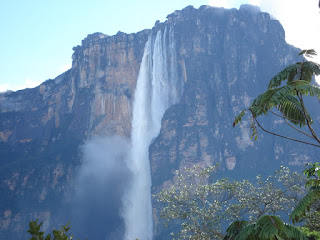Each of the countries of South America is unique, offering a number of attractions, scenic marvels, and distinctive cultures. While some cities and areas have world class established tourism infrastructure, most South America tourism development is much less advanced but rewarding in it's experiences.
In expanding our horizons, with Ecuador as our " central home base " for exploring the many majestic wonders of South America we would like to briefly recap. Our recent articles have focused primarily on areas, and events, of our new home country of Ecuador. We have much more exploration ahead, although to date we find we have explored and documented 50 % of the top South American destinations and wanted to summarize these adventures and create some further intrigue.
Countdown fifteen days until this years most important football event in Latin America - COPA America 2011 July 1 -24th hosted by Argentina. On May 28th Ecuador and Mexico played to a one-one draw in Seattle, and on June 1st Canada and Ecuador tied 2-2 in Toronto. A full schedule of games is available here :
Venezuela and Northern Columbia have mixed cultures heavily influenced by the Caribbean cuisine, music, and lifestyle.
Brazil, Uruguay, Argentina, and the Falkland Islands have warmer Atlantic Ocean exposure and varied climates, cultures and attractions, from the Amazonian jungles to the high plains of Patagonia. The highest mountain in South America, awesome waterfalls, glaciers, beach resorts and highly sophisticated European influenced cities.
Western Colombia, Ecuador, Peru, and Chile face the colder Pacific Ocean, and share the Andes. They have a wide variety of climates, from coastal desert to verdant forests,the Amazon basin, and the Galapagos Archipelago. Vibrant cities, scenic attractions and archaeological ruins attract visitors who enjoy the culture and cuisine.
Bolivia and Paraguay are surrounded ( landlocked ) by the others, although lacking a seacoast, they do have rivers leading to the sea.
The ten most popular cities in South America are often points of entry, capital cities, typically representative of their countries, or have distinctive attractions. Each city has its own distinctive charm and ambiance.
1. Buenos Aires, Argentina
The large, sprawling, sophisticated cosmopolitan capital city of Argentina situated on the banks of the Rio de la Plata has many neighborhoods, each with its own distinct flavor. Major attractions include Recoleta Cemetary - mausoleums of notable citizens including Eva Peron, Teatro Colon - second largest performing arts theater in the southern hemisphere, Avenida 9 de Julio the widest street in the world anchored by the Obelisk, Plaza de Mayo the original main square of Buenos Aires features European architecture of Casa Rosada, tango dance shows and BBQ argentine beef.
2. Rio de Janeiro, Brazil
Rio is spectacularly located, and cariocas and visitors enjoy a vivid lifestyle nestled between fabulous beaches and rainforested hills. We will be visiting when Brazil hosts the FIFA World Cup in 2014. For additional information now follow the city link above.

3. Santiago, Chile
Chile's capital city is very cosmopolitan, the financial, cultural, and political center of the country. Graced with tree-lined streets, parks, distinctive neighborhoods, and an wide assortment of restaurants and hotels. Plaza de Armas, Cerro Santa Lucia, Parque Forestal, Parque General Bustamente,intriguing Barrio Bellavista, and Parque Metropolitano. Santiago is near ski resorts and beach resorts, and some of Chile's newly famous wine growing regions.
4. Sao Paulo, Brazil
South America's largest city , Brazil's center of trade and industry. We will be visiting when Brazil hosts the FIFA World Cup in 2014. For additional information now follow the city link above.
5. Bogota, Colombia
A mixture of Spanish, English, and Indian cultures and influences Santafé de Bogotá is a city of contrasts. Universities and theaters aside shantytowns, modern highrise buildings next to colonial churches nestled high in the Andes ( 2620 m. - 8646 ft ) The emerald trade is a huge business in Bogotá.
6. Lima, Peru
A wealth of history and culture is often missed in this colonial city of Kings as visitors rush through on their way to Machu Picchu. At this time we too have only passed through its airport so by clicking the city link above will refer you to another information source.
7. Caracas, Venezuela
While other South American countries are romanticized for the Equator, chilean wine, the tango, Machu Picchu or Carnival, Venezuela's reputation is based on oil production, and the brash politicion - President Hugo Chávez. However, there is so much more to Venezuela- it is a country of amazing variety and remains undervisited by international travelers. Caracas the capital and largest city is set in a dramatic setting where the Andes meet the Caribbean Ocean.
8. Cartagena, Colombia
In 1533 Cartagena was one of the first cities founded by the Spaniards in South America. The old walled city and fortress repelled invaders and pirates in its early days. Now it is Colombia's most popular seaside destination welcoming visitors with its colonial charm, energetic nightlife and attractions.
9. Quito, Ecuador
One of our favourite's and certainly most often visited - Ecuador's capital at the middle of the world, some 475 years old, is a mix of colonial history and modern enterprise. It is often described as the most beautiful city in South America. Quito lies in a narrow valley that extends some 80 kilometers in length flanked by snowcapped volcanoes with amazing landscapes. It is an intriguing mix of old and modern. Certainly this was recognized in 1978 when UNESCO designated Quito as the world's first Cultural Heritage Site. A living treasure trove of architectural and colonial treasures.
10. Salvador, Brazil
Impressions of this lively city include Candomble, Baina do Acarages, the water, streets, Cairinhas, architecture and lots of beach time.
Carving a huge channel through a rainforest which is home to more wildlife species than anywhere else on earth, the Amazon river runs over 4000 miles from its origins to the Atlantic where in one second, it pours more than 55 million gallons of water into the sea. The Amazon basin covers more than two-fifths of South America's land mass.
The rocks and cliffs forming the tepuis were ancient long before the continent of South America separated from Africa. Now they are home to dense rain forests, clouds of mist and huge sandstone formations. From the top of one tepui, an unbroken stream of water forms the highest waterfall in the world taking 14 seconds for the water to fall to the base.
Easter Island, off the coast of Chile, is one of the world's most isolated inhabited islands. A UNESCO World Heritage site famous for its 887 extant monumental statues, called moai. Additional information on Easter Island
Called the world's greatest living laboratory, these barren islands in the middle of two cold currents support a fantastic array of wildlife that has developed into new forms such as the marine iguana and the flightless cormorant, huge sea turtles, plus sea lions and penguins far from their original habitats.
Multiple falls, formed when the Parana river drops between 197 and 262 feet into the river below, become almost one continuous flow of water when the river runs high.
An inlet from the Caribbean sea, this is the largest lake in South America, extending about 100 miles long and 75 miles wide. Lake Maracaibo was formed from mud deposits millions of years ago and now boasts huge petroleum deposits. Also famous for the unique phenomena of catatumbo lightning.
This high altitude lake, over 12,000 feet high and about 900 feet deep, this is the second largest lake in South America. With an area about 3200 square feet, 122 miles long with an average width of 35 miles, with 36 islands, the lake is reputed to be the highest navigable lake in the world
This " Lost city of the Incas " built in the 1400's high on a mountain ridge in Peru. This peruvian historical sanctuary has also been declared a UNESCO World Heritage Site.
Patagonia in Argentina and Chile is home to great glaciers, volcanos, glacier fed lakes, and fast rushing rivers. Majestic volcanos like Osorno in Chile, Perito Moreno Glacier in Argentina and the fantastic fjords of Chile are all reminders of the wonders of nature. Seen here: Glacier
Patagonia
28,470 square miles in size, separated from the southern tip of the South American mainland by the Strait of Magellan, Tierra del Fuego is cold, windy and wildly scenic.
As we return to our home in Bahia de Caraquez thanks for traveling with us today, and hopefully we will have created some intrigue for you to adventure and experience some of South America's treasures for yourself.





















































